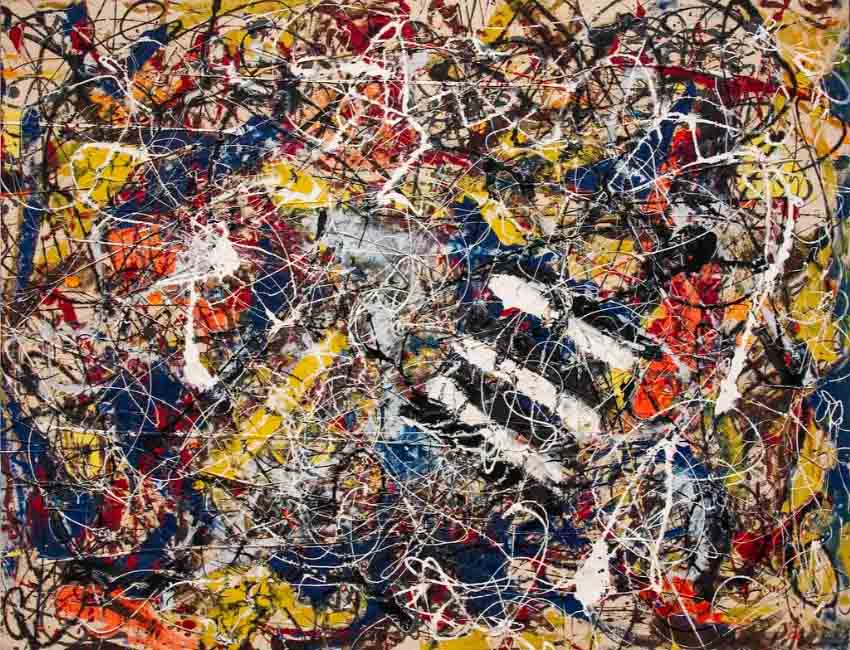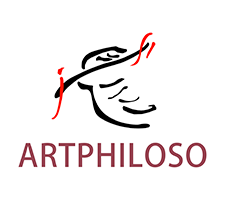These artworks illustrate how value, history, and emotion converge in the global market of abstract painting.
1. "No. 17A" by Jackson Pollock – $210 Million
Jackson Pollock’s signature work "No. 17A" remains a landmark of abstract painting. In 2025 it was re-valued at an estimated $210 million during a private appraisal that involved Christie’s in New York. Originally sold in 2016 for $200 million, the painting has become a symbol of the post-war American art boom. Pollock’s drip technique—an explosive, rhythmic pouring of paint—translated raw emotion into visual form.
Collectors prize this piece for its historical importance and rarity. Few of Pollock’s large-scale drip paintings remain in private hands; major institutions still organize retrospectives and preserve his legacy.
Pollock’s legacy shows that abstraction can capture emotion beyond representation, securing both artistic and financial immortality.

2. "Untitled (New York City)" by Cy Twombly – $90 Million
Cy Twombly’s "Untitled (New York City)" from 1968 exemplifies his signature style of spontaneous loops and chalk-white lines on a slate field. In 2025 the work sold through Sotheby’s in London for $90 million, setting a new record for the artist. Twombly’s abstraction invites viewers to experience language reduced to gesture.
This sale reflects growing global interest in contemplative abstraction—demand from both Western and Asian collectors. Notably, Art Basel Hong Kong 2025 featured a strong showing of Twombly-inspired works from younger artists.
The rising demand for Twombly’s meditative abstraction highlights a global appetite for subtlety and introspection in art.

3. "Composition No. II" by Wassily Kandinsky – $72 Million
A newly rediscovered work by Wassily Kandinsky titled "Composition No. II" sold at Phillips New York in 2025 for $72 million. Painted in 1910, the piece demonstrates Kandinsky’s effort to visualize music through color and form—his concept of “inner necessity.”
The sale strengthens Kandinsky’s role as a foundational figure in abstraction and signals renewed interest in early-20th-century European work. Institutions such as the Guggenheim Museum and Centre Pompidou continue to deepen their collections, raising demand.
Kandinsky’s vision remains a philosophical cornerstone of abstract art, linking historical innovation to contemporary market strength.
4. "Flesh and Spirit" by Jean-Michel Basquiat – $165 Million
Though Jean-Michel Basquiat is often associated with neo-expressionism, his 1983 diptych "Flesh and Spirit" embodies raw urban abstraction. In early 2025 it was resold privately for $165 million, establishing a benchmark for contemporary Black American artists. The piece blends graffiti-like marks, anatomical references, and spiritual symbols.
The painting expands the definition of “abstract” to include cultural narratives beyond classic European modernism. Major exhibitions at the Whitney Museum of American Art and The Broad reinforced Basquiat’s global influence.
Basquiat’s abstraction broadens modern art’s scope by merging cultural identity with emotional immediacy.

5. "Untitled (Color Field)" by Mark Rothko – $195 Million
Mark Rothko’s "Untitled (Color Field)" from 1958 reached a record $195 million at Christie’s New York in mid-2025. The painting features Rothko’s large floating rectangles that evoke both serenity and sorrow. The buyer, an unnamed tech entrepreneur, reportedly described the work as “a silent dialogue with existence.”
Rothko’s market remains robust thanks to limited supply and ongoing institutional demand. Retrospectives at the Tate Modern and The Metropolitan Museum of Art reaffirm his prominence in both art history and investment circles.
Rothko’s timeless emotional abstraction proves that silence and simplicity remain the ultimate luxury in art.
Global Trends in Abstract Art Investment (2025)
Beyond individual works, 2025 marks a shift in how collectors buy abstract art and how they assess abstract painting cost. Online platforms such as Artsy, 1stDibs, and Saatchi Art have made high-quality abstraction accessible beyond elite auctions. At the same time, keyword searches for “buy abstract art” continue to rise in global search volume.
The spectrum of abstract painting cost now spans from modest emerging-artist pieces to multi-million-dollar blue-chips. Digital forms of abstraction, including NFTs on platforms like SuperRare and Foundation, are gaining traction. These trends show that abstraction’s value lies both in its material presence and its conceptual depth.
The 2025 art market confirms that abstraction is both timeless and adaptive—bridging traditional mastery with digital innovation.
Economic and Cultural Drivers Behind High Valuations
The growing population of ultra-high-net-worth individuals in the United States, United Kingdom, and Asia-Pacific has intensified competition for top-tier artworks. Art is increasingly viewed as a hedge against inflation and a badge of cultural influence.
At the same time, reports such as the Art Basel & UBS Global Art Market Report highlight that abstraction is outperforming figurative art in year-over-year appreciation. This shift is supported by academic research on abstraction’s psychological impact and its universal appeal.
Economic stability, global mobility and digital transparency have made abstract art one of the most resilient asset classes in 2025.
How to Evaluate Expensive Abstract Art for Sale
When exploring expensive abstract art for sale, care and diligence matter. Authenticity, provenance and condition are critical. Collectors should request documentation from recognized archives or foundations—such as the Pollock-Krasner Foundation or the Rothko Estate. Working with reputable galleries and auction houses reduces risk and increases transparency.
Beyond emotional attraction, informed buyers consult market tools like Artnet Price Database and MutualArt to assess comparative values. Many collectors also engage art consultants to balance aesthetic satisfaction and financial performance.
The best investments in abstract art balance passion with informed strategy, combining emotion with expertise.
Conclusion
The five most expensive abstract paintings of 2025 reflect a dynamic global market shaped by diversity, emotion and innovation. From Pollock’s explosive movement to Rothko’s quiet contemplation, each work contributes a unique voice in the language of abstraction. These masterpieces remind us that abstraction—though non-representational—continues to express the complexity of human experience. As the art world evolves, the definition of value also evolves, now shaped by emotional impact, rarity and the timeless dialogue between artist and viewer.
Abstraction remains the purest form of artistic freedom—unbound by image yet deeply connected to human emotion.
About Artphiloso
Hi, I’m Philo, a Chinese artist passionate about blending traditional Asian art with contemporary expressions. Through Artphiloso, my artist website, I share my journey and creations—from figurative painting and figure painting to floral oil painting and painting on landscape. You'll also find ideas for home decorating with paint and more.
FAQs:
What determines the price of an abstract painting?
Prices are shaped by artist reputation, provenance, historical importance, condition and market demand. Auction results from Christie’s, Sotheby’s, and Phillips serve as benchmarks.
Is abstract art still a good investment in 2025?
Yes. Many abstract works have proven resilient over decades and during economic shifts. Collectors increasingly view abstraction as part of a diversified investment approach.
Where can I buy authentic abstract paintings?
Reputable sources include online platforms like Artsy, 1stDibs, and Saatchi Art, as well as major auction houses and established galleries. For emerging artists, gallery exhibitions and digital platforms provide entry points.
What is the typical abstract painting cost for collectors?
For emerging artists, works often range from several thousand to tens of thousands of dollars. For established names or blue-chip pieces, prices can exceed hundreds of millions. Size, medium and provenance play significant roles.
How do I verify authenticity before purchase?
Request documentation from artist estates, archives or authentication boards. Work with trusted galleries or advisors to ensure authenticity, clear title and long-term value.
Which artists dominate the abstract art market in 2025?
Leading figures include Jackson Pollock, Mark Rothko, Cy Twombly, Jean-Michel Basquiat and Wassily Kandinsky.
Why does abstract art remain so valuable?
Its broad appeal, emotional depth and rarity continue to drive demand. Abstract art transcends cultural boundaries, making it both personal and global, which adds to its enduring value.
